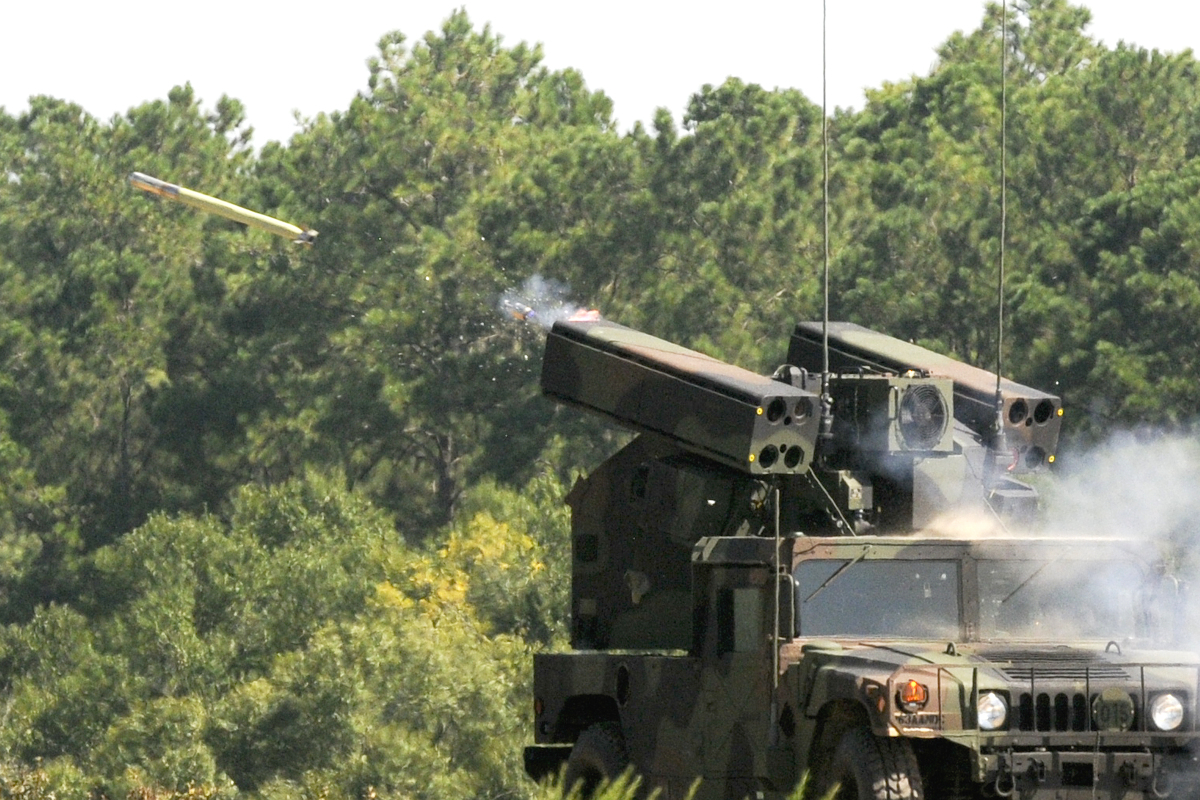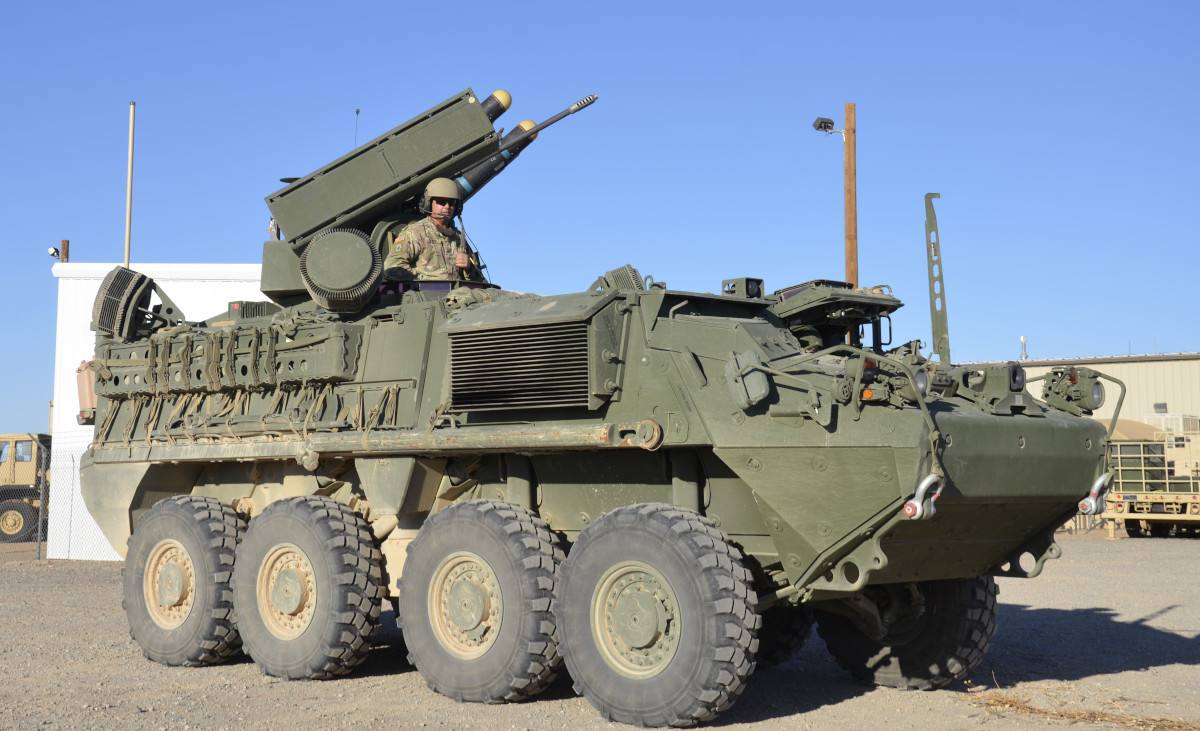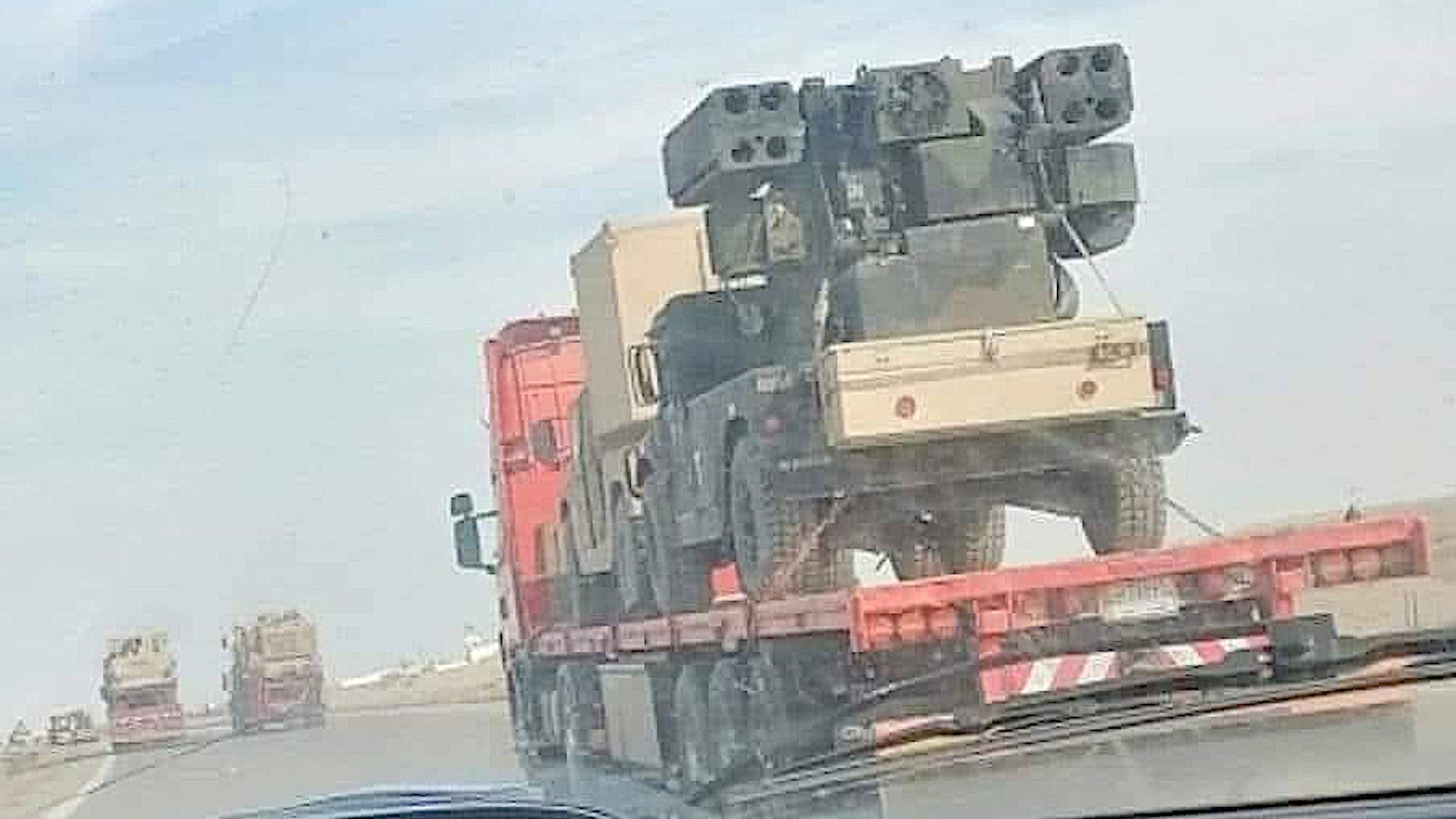Pictures have appeared on social media that reportedly show trucks carrying Avenger short-range air defense systems on a highway between the Iraqi city of Ramadi and the Syrian border. The Avenger is primarily designed to engage low-flying manned fixed-wing aircraft and helicopters, but can also be employed against drones. Two weeks ago, the top U.S. general overseeing operations in the Middle East said that the ever-growing threat posed by small unmanned aircraft was “the most concerning tactical development” since improvised explosive devices became the weapon of choice for militants and terrorists in the region.
The pictures first began to circulate on social media on Feb. 21, 2021, but it is unclear when or where exactly they were taken. It’s also not clear, if their reported location is accurate, whether these vehicles were heading to or from the Syrian border. Ramadi is situated at the nexus of two major highways in western Iraq that lead to Syria.

It is possible that these air defense systems could be headed toward forward bases that U.S. and other coalition forces operate out of in cooperation with local, predominantly Kurdish groups, in Syria’s northeastern Deir ez-Zor governorate. The convoy could also be moving in the direction of the highly strategic U.S. garrison at At Tanf, situated in Syria further to the south, near the Iraqi and Jordanian borders. As of the beginning of this month, there were approximately 900 American troops spread across these various Syrian outposts, according to the Pentagon.

The Avenger, also known as the AN/TWQ-1, is a turreted short-range air defense (SHORAD) system with two launchers, each capable of holding four FIM-92 Stinger heat-seeking surface-to-air missiles, as well as a .50 caliber M3P machine gun. The turret is most commonly employed mounted on the back of a Humvee, but can be also be emplaced in fixed positions on the ground and atop structures.

The system has a single operator who targets threats using a combination of an infrared camera, optical sight, and laser range-finder. The Avenger can also be cued using offboard sensors, such as the AN/MPQ-64 Sentinel radar, via a centralized fire direction center.
In recent years, the Army has also fielded improved versions of the Stinger missile that are optimized for use against small drones. This has included the addition of a new, more sensitive radar proximity fuze with a conformal antenna that wraps around the warhead assembly.
There was an unconfirmed report on social media in January 2020 Avengers had been sent into Syria via Iraq, along with High Mobility Artillery Rocket Systems (HIMARS), but no pictures had emerged reportedly showing the vehicles in the region at that time. So, there is also the possibility that this reported convoy in Iraq could be bringing a new air defense detachment to relieve or reinforce existing elements in Syria, or represent the relocation of assets out of that country as part of ongoing drawdowns there and in neighboring Iraq.
The report of the deployment of Avengers to Syria last year notably came around a month after a story from Newsweek said that U.S. officials were seeing a worrying uptick in drone activity near unspecified U.S. operating locations in the Middle East, potentially linked to Iran or its regional proxies. This was, of course, a period where tensions between Washington and Tehran were especially high. That friction ultimately culminated in the death of Iranian General Qassem Soleimani in a U.S. military drone strike in the Iraqi capital Baghdad and subsequent unprecedented Iranian ballistic missile strikes on bases hosting American troops in Iraq.
In March 2020, it was revealed that U.S. forces in Syria were being subjected to attacks from small drones armed with grenade-like munitions, though it was unclear who was operating them. While Iranian-backed militias in Iraq and Syria are certainly known to have this kind of capability, ISIS terrorists have also carried out these kinds of attacks and had made particularly notable use of this tactic during the fighting in and around the Iraqi city of Mosul between 2016 and 2017. Small drones can also be used to simply surveil American positions, gathering valuable intelligence could be used to plan other types of attacks. m
If Avengers did indeed head into Syria, if there weren’t already examples of these systems deployed there, they would certainly offer American troops there an extra line of defense against small drones. Earlier this month, U.S. Marine Corps General Frank McKenzie, head of U.S. Central Command, publicly expressed his view that smaller unmanned aircraft, including hobbyist types modified to carry improvised munitions, present the most significant and growing threat to U.S. forces in the region since terrorists and militants began actively using roadside bombs in Iraq following the American-led invasion of that country in 2003.

“The growing threat posed by these systems coupled with our lack of dependable, networked capabilities to counter them is the most concerning tactical development since the rise of the improvised explosive device in Iraq,” McKenzie said at a gathering hosted by the Middle East Institute think tank in Washington, D.C., on Feb. 8. “They provide adversaries the operational ability to surveil and target U.S. and partner facilities while affording plausible deniability and a disproportionate return on the investment, all in our adversaries’ favor.”
“These systems are inexpensive, easy to modify and weaponize, and easy to proliferate,” he added, stating that the kinds of unmanned aircraft he was talking about were ones that anyone could buy from a store like Costco for around $1,000. McKenzie has made similar comments about opponents employing smaller, relatively low-cost drones multiple times in the past, as well. This low barrier to entry has already led to their increasing use among state and non-state actors, including terrorist groups and organized criminal enterprises, and only increased the potential threats they pose, something we at The War Zone regularly highlight.
“Right now, the fact of the matter is we’re on the wrong side of that equation,” he said with regards to this threat at another Middle East Institute event in June 2020.
The SHORAD systems could also provide an additional and more immediate measure of protection against larger unmanned and manned aircraft, which forces aligned with Syrian dictator Bashar Al Assad, including Iranian-backed militias, have employed against U.S. personnel and their partners in the country in the past. American combat jets in the region, primarily U.S. Air Force F-15E Strike Eagles based in Jordan, have otherwise been the go-to assets for responding to aerial and other threats to U.S. interests in Syria in the past six years or so.
The Avenger is the only vehicle-based SHORAD system in any sort of widespread use in the U.S. military, at present. American SHORAD capabilities dramatically atrophied after the end of the Cold War, something you can read about in more detail in this past War Zone feature. Until recently, in the U.S. Army, the remaining Avengers had been almost exclusively assigned to National Guard units, with the U.S. Marine Corps also operating a small number of them.
When it comes to other SHORAD capabilities, standard Man-Portable Air Defense System (MANPADS) versions of the Stinger are also available, as are a limited number of Centurions. This latter system is a ground-based version of the U.S. Navy’s 20mm Vulcan cannon-armed Phalanx Close-in Weapon System (CIWS), which you can read about in more detail in this past War Zone story, and is intended primarily to knock down incoming rockets, mortar bombs, and other artillery rounds, but could also be employed against small drones.

Last year, U.S. personnel in Syria began to receive an advanced targeting system for their M4 carbines, which, among other things, makes it easier to engage small drones. You can read more about the capabilities that the Israeli-made Smart Shooter SMASH 2000 offers in this past War Zone piece.
The U.S. Army, in particular, has been trying to fill this glaring capability gap in recent years, including with the activation of a number of active-duty Avenger-equipped units between 2017 and 2019. This includes forward-deployed elements in Germany and South Korea, as well as three more batteries at bases in the United States.
As of 2019, one of these is part of the so-called Global Response Force (GRF) at Fort Bragg in North Carolina, a crisis response task force available for rapid deployment anywhere in the world on short notice. The GRF subsequently morphed into the Immediate Response Force (IRF), which was employed for the first time in the aftermath of the Iranian ballistic missile strikes in Iraq in 2020.
There are no clearly visible markings on the Avengers in the pictures of the reported convoy in Iraq to help identify what unit or units they might belong to.
The U.S. military, as a whole, is in the process of acquiring various new SHORAD and dedicated counter-drone systems, as well, including laser and high-powered microwave directed energy weapons. In December 2020, the U.S. Air Force disclosed that it had deployed one such system, an example of its Tactical High Power Microwave Operational Responder, or THOR, to an undisclosed location in Africa for a field trial.
In addition, the Army just recently completed a round of tests with a new air defense system mounted on a modified 8×8 Stryker wheeled armored vehicle and is now close to fielding the first examples of that design. Known as the Initial Maneuver Short Range Air Defense (IM-SHORAD), this system features a turret armed with both Stinger and millimeter-wave radar-guided AGM-114L Longbow Hellfire missiles, as well as a 30mm automatic cannon.

The service has also received two batteries worth of the Israeli Iron Dome system, which is primarily designed to engage the same kinds of threats as Centurion. The manufacturer, Rafael, says improvements to Iron Dome over the years have expanded its more general short-range air defense capabilities, including against cruise missiles, too.
All told, regardless of whether or not the U.S. military has deployed a contingent of Avengers to Syria or not, the threat of small drones armed with improvised munitions, in Syria and beyond, is real. As such, together with the dangers posed by more traditional aerial threats, Avengers, as well as other SHORAD systems, look set to simply become an increasingly routine component of American military activities around the world, inside and outside of actual war zones.
Contact the author: joe@thedrive.com
